John Deere Global Strategy
8Role:
Manager, Information Architect
Team: Business Strategists, Tech Lead, Creative Director, Ux lead, Research lead, Design lead, Content strategist
Agency: Sapient
Client: John Deere
Year: 2009
Task
John Deere tasked Sapient to come up with a global digital strategy to transform and unify all their existing sites. The main objectives:
- Increase the conversion of current and potential customers.
- Improved efficiency for business processes within Deere, dealers and distribution partners
- Extend brand loyalty through more products purchased, repeat purchases, and service.
- Increased conversion of prospective employees, improving overall acquisition cost and investment per employee.
Method (UX only)
- Created a detailed competitive analysis across their key industries: agriculture, construction and forestry equipment. (partenered with research person)
- Interviewed 40 farmers, builders, small business owners on forestry and landscape and turf) across the US and Germany in oder to understand their business and process. ” (partnered with business strategist)
- Participated in US and Germany focused workshops uncovering and prioritizing needs and developing a roadmap. (the whole team)
- Developed gloabal system maps, sitemaps, taxonomy studies
- Created key wireframes to present functionality
Competitive Assessment
Sapient’s Interactive Assessment looks at both JohnDeere.com, as well as 20 competitive and industry-leading sites, in close detail, using a 43-point inspection to evaluate four critical areas of overall experience design. On the whole, the results were not unexpected, but in process, we have not only been able to establish a baseline for future evaluation, but we have also been able to identify clear opportunities forJohnDeere.com to be highly successful in the years to come.
Assessment Result
Feature Chart
Features Percentages
Sample of Evaluation Worksheet
User Research
Design criteria to guide our solutions and deliver results.
We travelled around the world interviewing customers and partners in agriculture, construction, forestry, lawn and turf, dealerships, and selling parts businesses. Our objective was to understand the breadth and depth of experiences needed to deliver.
We asked about their day to day activities, crucial needs in their business, what sites do they use for work. Some of our learnings were:
- It is crucial to have access to their local dealerships and part sellers. Getting a broken part should be a very fast process since they are only a few days for harvest.
- Buying a tractor is a big deal people get a golden key with their purchase. The Product page should have relevant content.
- JohnDeere.com should allow customers to connect to get work done. The user’s page should log in all real-time data connected to their product.
- Nobody knows about all the satellite sites except for the finance related ones. Some country sites have no valuable content, it is better to just skip them.
Interview logs for the US
Assessment Result
- Farmers work is seasonal and time sensitive – We only have 30 days to do our work
- Family farmers are constantly searching for used equipment, but like to buy from local areas
- Small Business Farmers seek for financial advice. They trust their accountants for tax purposes and for purchasing product opportunities. (example: Brian Westerndorf 33::57)
- Ordering new equipment requires a long time wait (example: Jake Burge)
- Precision Farming is new to “old school” farmers, generating awareness of its benefits would incent them to adopt the new technology (example: Duane McKinney 30::45)
- For custom farmers hay is the number one priority since it is easier to harvest than straw
- We need to maximize the use and maintenance of our fleet
- We need to make sure we order the right parts (example: Jon Kyser – he gets wrong parts almost every week)
- Buy “auto-order” high turnaround consumables
- Purchase products that “fit” in transportation (example: Chris Peppers buys equipment that fits within the transportation vehicle to reduce cost, time and for environmental purposes)
- Try to keep the least parts in inventory (
- Focus on revenue and best financial decisions (example: Teresa Aston is interested on the financial aspect. E.g. Should they lease or buy, Should they get the service contract or maintenance option)
- Depending on the size of the fleet some users create their own excel sheets and some others use robust application programs
- Some programs are not user friendly and users “learn new things” every day
- Standardizing the fleet and dealers makes the job easier
- What do I need for “x” project? (example: Kevin Williquette)
- What can I do with “x” product? (example: Kevin Williquette)
- I want to see the product working. (example: Rhys Helt)
- What do I do to service and maintain my product?
- I am using this equipment to work my property but as a hobby too (example: Rhys Helt and Eric Louks)
- Large property owners appreciate their products can do heavy lifting jobs and aren’t only “toys”
- I need to understand the big picture of some projects (example: Rhys Helt would like to know How do I plant a horse paddock, How do I plant a field). What are the steps, what are the products I need.
- Some of these customers may be have a business background and could consider purchasing John Deere stock. (Rhys Helt looks at JD stock, commodities and earnings)
- Purchasing parts for residential is easy and intuitive
- Residential buyer has no knowledge of technical information (example: Kevin Williquette)
- Fertilizers are very expensive – (example: Chris Peppers Since the price of fertilizers is so unstable, we bought at a fix price our needs for a year. We get it as we need it, instead of having it on our inventory)
- There are many niches within this market: vineyards, nurseries, grass beads
- Each niche has different necessities
- Training – Spanish speaking materials are used for their workers (e.g. Cliff Helvie)
- Certifications – makes our business competent and makes us stay on edge (e.g. Chris Peppers)
- Products for wet grass are a local needs for Oregon
- What are the incentives for buying JD related products (chemicals, oil …) Example: Cliff Helvie – He would appreciate having Lesco chemicals with Deere rate. Since these chemicals are so expensive we end up using 70% of generic label.
- Interest in communicating with Dtek for product feedback (John Deere products have some third party fans that brake easily, instead of telling the delaer I would prefer to tell John Deere Dtek team)
- Manual entries for parts is time consuming, dealers might prefer using their own tools since it synchs all data at night (Duane McKinney1::19::24)
- Try to keep the least parts in inventory (Duane McKinney 1::00::51 Portland is opening a parts warehouse which will allow us to provide parts faster keeping less inventory)
Key Themes
- Resale value
- Financial plan
- Service and maintenance plan
- Dealer proximity
- Parts availability within the area
- Relationship with the dealer
- The product upgrade changes hookups and is now compatible to more attachments (example: Brian Westerdorf 16::20)
- Tax depreciation
- Do their work better and more efficient – Keep their clients happy
- Using annual budget for primary and secondary needs
- For smaller equipment (landscape) – Making sure it fits in their transportation vehicle
- Equipment should always be in good conditions and constantly in use
- Servicing the equipment and purchasing parts should be done in the least time possible
- Currently, it is easier to call the dealer than to find and understand the online processes for my needs
- Servicing equipment in off hours prevents it from loosing a day’s work
- Having a robust fleet management system, helps track data, although it requires a lot of manual data entry.
- Standardizing the fleet and consolidating the dealers makes the job faster
- Purchasing products that are compatible with each other in order to share attachments
- Loose inventory space – saves space and “sitting” money
- Knowledge of equipments repair history to anticipate future problems
- Knowledge on key financial decisions to get the best revenue
- Planning product purchase through annual budgets
- Customers browse online, read magazines and go to expos, but when they are ready to buy they call their dealer for product recommendations and advice.
- Dealers provide customers a personalized experience by giving them special prices according to who they are.
- Dealers know what the customer owns and provide relevant recommendations on what to get.
- Dealers provide effective service programs that make them reliable and trustworthy. Some of these services are: picking up equipment from customers address, taking parts to customers. Customers appreciate these programs since oil prices are getting high and they don’t have loose time.
- Customers appreciate calls from dealers to let them know about a product that just arrived to the store that is exactly what they were looking for. E.g. example of Eric Louks – he bought his gator based on a phone call from the dealer telling him a used gator just came in.
- Customers appreciate when dealers take products to home for demonstrations. E.g Rhys Helt bought his lawnmower after he saw it working at his home.
- People focus on their industry, their region, and their currency’s footprint (e.g., EU)
- They may keep an eye on the rest of the world, but they only really use topline information
- Special equipment based on your location. E.g wet grass products.
- Purchase of used equipment near the customers location
- Custom farmers promote their business through word of mouth
- People have different needs at different times depending on the season
- Customers would appreciate having more visibility on who carries the parts they need and the time it takes to get them
- Dealers would appreciate having an easier solution to update their parts catalog online
Strategy
Design criteria to guide our solutions and deliver results.
User research, an assessment of leading competitors, and a review of John Deere’s current strategy have resulted in this set of customer-focused criteria for the future of the company’s global Internet platform
- JohnDeere.com must reflect the products and information available in each region and simplify
navigation to be focused on solutions rather than map to the organization’s structure. - Show, don’t tell–JohnDeere.com must be more visually illustrative and less textual.
- Associated or complementary information and products must be displayed in-line with the
item (product, article, job, etc.) being viewed.
Existing Digital Ecosystem
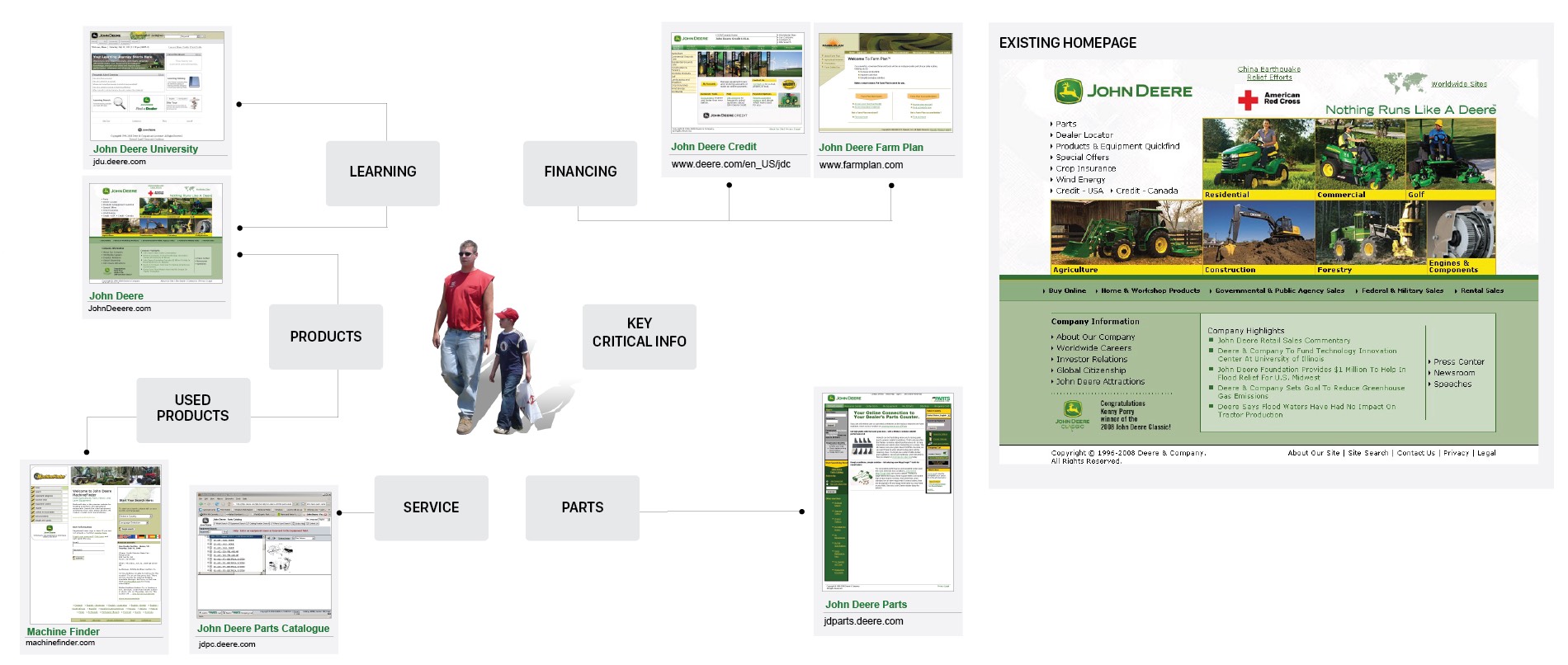
Proposed Digital Ecosystem

Wireframes

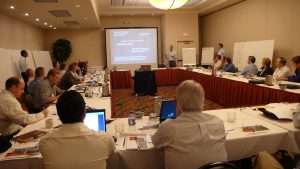



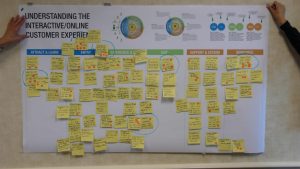


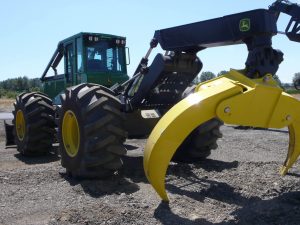
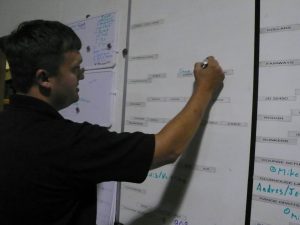


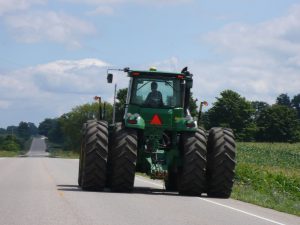
 by Elaine Keller
by Elaine Keller